chords for bass guitar pdf
Bass guitar chords involve playing multiple notes simultaneously, creating harmony․ This differs from typical basslines, which emphasize single notes․ Understanding chords expands a bassist’s musical palette, enabling richer accompaniment and creative expression․ Explore basic triads and seventh chords to begin your journey․
Understanding Bass Guitar Chord Charts
Bass guitar chord charts visually represent finger positions on the fretboard․ These diagrams typically depict the nut, frets, and dots indicating where to place your fingers․ Numbers inside the dots often specify which finger to use․ Reading a chart involves identifying the root note, and understanding the interval pattern the chord is built upon․ Charts can show standard triads, seventh chords, and more complex voicings․ Some charts offer fingering suggestions while others leave it to the player’s discretion․ Learning to interpret these diagrams unlocks a world of chordal possibilities on the bass․ They provide a map for creating harmonies and understanding chord structures on the fretboard․ It’s crucial to familiarize oneself with the basic layout and symbols to effectively utilize charts for learning songs and exploring musical ideas․
Common Bass Guitar Chords
Common bass guitar chords include major and minor triads, as well as seventh chords․ These are fundamental for building basslines and creating harmonic accompaniment․ Understanding their structure is crucial for bassists․
Major Triads on Bass Guitar
Major triads on the bass guitar are foundational chords, consisting of the root, major third, and perfect fifth intervals․ For instance, a C major triad includes the notes C, E, and G․ These chords are typically represented by their root note, such as “C” for C major․ Major triads create a bright and uplifting sound and are prevalent in numerous musical styles․ Understanding these triads allows bassists to create basic harmonic structures․ These can be played in various positions on the fretboard, offering flexibility in your playing․ Fingerings can vary, but the core intervals remain consistent․ Mastering major triads is essential for any bassist aiming to play chords․ They serve as a basis for more complex chord voicings and progressions․ They can be used for creating bass lines, accompanying other instruments, or creating chordal textures․
Minor Triads on Bass Guitar
Minor triads on the bass guitar are essential for creating a contrasting, darker sound compared to major chords․ A minor triad consists of the root, minor third, and perfect fifth intervals․ For example, an A minor triad comprises the notes A, C, and E․ These chords are typically represented by their root note followed by “m,” such as “Am” for A minor․ Minor triads are widely used in music and offer a melancholic or introspective feel․ Understanding their structure is crucial for bassists who wish to expand their harmonic vocabulary․ Minor chords, like major chords, can be played in numerous positions across the bass fretboard․ The fingering may vary, but the root, minor third, and fifth intervals will always be the same․ They provide a fundamental building block for basslines and harmonies in many music genres․
Seventh Chords on Bass Guitar
Seventh chords on the bass guitar add a layer of complexity and richness compared to basic triads․ These chords consist of four notes⁚ the root, third, fifth, and seventh intervals․ The most common seventh chords are major 7th, minor 7th, dominant 7th, and diminished 7th․ A C major 7th chord includes C, E, G, and B, while a C minor 7th has C, Eb, G, and Bb․ Dominant 7th chords, such as C7 (C, E, G, Bb), are frequently used for creating tension and resolution․ Diminished 7th chords, like Cdim7 (C, Eb, Gb, Bbb), offer a dissonant and unstable sound․ Mastering these chord types opens up new harmonic possibilities for bassists․ They are used extensively in various musical styles including jazz, blues, and pop․ Understanding seventh chords enhances a bass player’s harmonic awareness and creative potential․
Bass Guitar Scales and Their Relation to Chords
Scales and chords are deeply interconnected․ Scales provide the notes for constructing chords․ Understanding this relationship allows bassists to create melodic basslines and understand harmonic movement․ Knowledge of scales aids in improvisation․

Major Scales and Their Patterns
Major scales are foundational for bass guitar playing and understanding chords․ These scales follow a specific pattern of whole and half steps⁚ whole, whole, half, whole, whole, whole, half․ Learning these patterns on the fretboard is crucial․ Each pattern has five distinct shapes across the neck, allowing players to move easily between positions․ Mastering these patterns unlocks improvisational possibilities and helps in constructing basslines related to chord progressions․ Practicing major scales will also improve finger dexterity and strengthen the connection between your ear and your fingers․ Additionally, major scales are the basis for constructing major chords and understanding diatonic harmony, making them essential for any bassist’s toolkit․ Understanding the relationship between scale tones and chord tones will help you to play more melodically and purposefully․ Remember to practice these scales in various keys and positions to gain a complete understanding of their application on the bass guitar․ You can also use free PDF resources to learn scale patterns and exercises․
Pentatonic Scales on Bass
Pentatonic scales, both major and minor, are essential for bassists due to their simplicity and versatility․ These five-note scales are derived from major and minor scales, omitting certain intervals, making them easier to play and improvise with․ The major pentatonic consists of the root, major second, major third, fifth, and major sixth degrees of a major scale․ The minor pentatonic scale includes the root, minor third, fourth, fifth, and minor seventh degrees․ These scales are widely used in genres like rock, blues, and country, making them indispensable for many musical styles․ Bass players should practice these scales in different positions on the fretboard to enhance their ability to solo and create interesting melodic lines․ Additionally, learning the relationship between pentatonic scales and chord tones is critical for effective improvisation and for creating bass lines that complement chord progressions․ The simple structure of pentatonic scales makes them an ideal starting point for any bass player looking to expand their melodic vocabulary․ Remember to practice regularly using PDF resources available for scale exercises․
Practical Application of Bass Chords
Bass chords aren’t just theoretical; they’re practical tools․ Learning to read diagrams and charts helps you play songs․ These skills improve your ability to create basslines and play with other musicians effectively and creatively․
Reading Bass Chord Diagrams
Bass chord diagrams are visual representations of finger placements on the fretboard․ They display the nut, which is the line at the top, and the horizontal fret lines․ Dots on the diagram indicate where to place your fingers, and numbers inside the dots suggest which finger to use․ Typically, 1 is the index finger, 2 is the middle finger, 3 is the ring finger, and 4 is the pinky finger․ A zero indicates an open string․ Understanding these diagrams is crucial for learning chords․ The diagram helps you visualize the chord shape before you play, making it easier to learn and remember chords․ These diagrams are an essential tool for any bassist wanting to expand their chord knowledge and playing ability․ Some diagrams might show root notes, thirds, and fifths, enabling you to see the structure of the chord․ This helps you learn the theory behind the chord․
Using Chord Charts for Learning Songs
Chord charts are invaluable tools when learning new songs․ They provide a simplified structure of the chords, indicating which chords to play and when, without detailing every single note․ This allows you to focus on the rhythm and overall feel of the music․ Bassists can use chord charts to understand the harmonic structure of a song․ Some charts include rhythmic notation, but often they just show chord changes, which allows the bass player to create their own bass line․ By using these charts, bassists learn to follow chord progressions and create bass lines that support the music․ Start by practicing simple chord progressions, then gradually move to more complex songs․ Learning to read charts is a fundamental skill for any musician, especially when playing in bands or ensembles․ It is a great way to learn bass parts for songs․

Free Resources for Bass Chords
Numerous free resources exist online for bass chords․ These include printable PDF charts, which are useful for practicing and learning․ Additionally, many websites provide free bass scale exercises in PDF format․ Take advantage of these free resources․

Printable Bass Chord Charts in PDF
Printable bass chord charts in PDF format are invaluable tools for bass players of all skill levels․ These charts offer a visual representation of various chords, displaying finger placements on the fretboard․ They commonly include diagrams for major, minor, and seventh chords, providing a solid foundation for learning․ Many websites offer these charts for free, often in A4 or US Letter sizes for easy printing․ These PDF resources are beneficial for practice sessions, allowing players to quickly reference chord shapes․ Some charts also include scale diagrams, further enhancing their educational value․ Having a collection of printable bass chord charts can greatly assist in memorizing chord shapes and expanding your knowledge․ These resources are a convenient way to learn new chords, and they serve as a practical reference while practicing or learning new songs․ Some resources also offer blank chord charts, enabling you to create your own personalized reference materials․
Free Bass Scale Exercises PDF
Free bass scale exercises in PDF format are excellent resources for bassists wanting to improve their technique and musicality․ These downloadable exercises usually feature common scales like major, minor, and pentatonic, with detailed fingerings and patterns․ The PDFs often include various exercises, such as ascending and descending scales, scale patterns, and arpeggios․ They provide structured guidance for practice, helping players develop finger dexterity and fretboard familiarity․ Using these free resources, you can build a solid understanding of scale patterns and their relationship to chords․ These exercises often include a metronome, encouraging you to practice with rhythm and timing․ They are readily available online, making them accessible to everyone․ A structured scale routine is a crucial aspect of bass guitar practice, and having these free PDFs can be a great way to improve skills․ The PDF format allows for easy printing and portability, facilitating practice anywhere․


